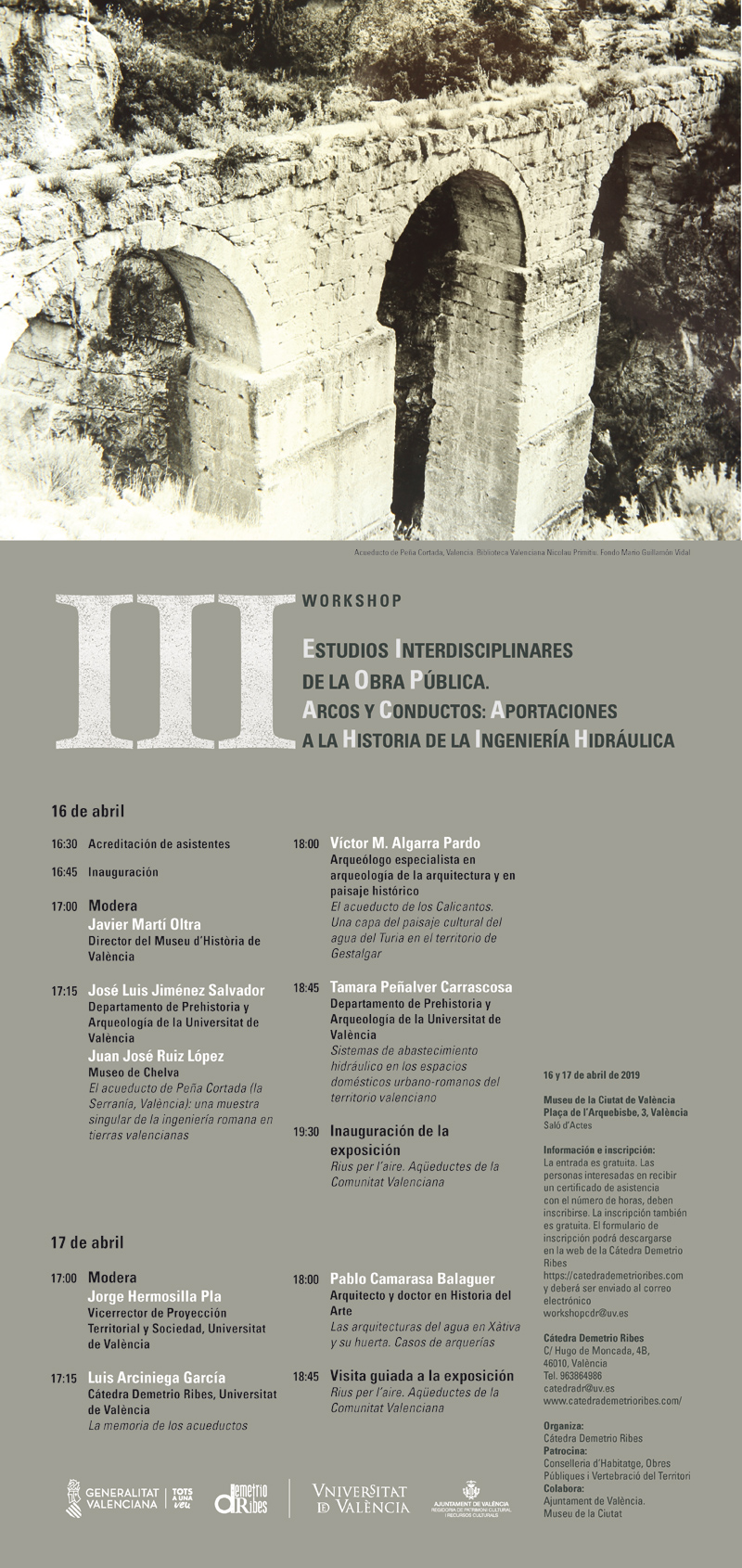Celebration of the 3rd Workshop on 16 and 17 April

16-17 April 2019
City Museum. València. Conference room.
Programme
16 April
16:30 - 16:45 Accreditation of participants
16:45 - 16:55 Inauguration presented by:
María Barceló Chico (Director of the City Museum of Valencia)
María Dolores Real García (Vice-rector of Innovation and Transfer at the Universitat de València)
Luis Arciniega García (Director of the Demetrio Ribes Chair, Universitat de València)
17:00 - 19:25 Conferences
Head of the table: Javier Martí Oltra. Director of the History Museum of València
17:15 Professor José Luis Jiménez Salvador. Departament of Prehistory and Archaeology of the Universitat de València. Juan José Ruiz López. Museum of Chelva
El acueducto de Peña Cortada (la Serranía, Valencia): una muestra singular de la ingeniería romana en tierras valencianas
18:00 Víctor M. Algarra Pardo. Archaeologist, expert in architecturial archaeology and historical landscape. El acueducto de los Calicantos. Una capa del paisaje cultural del agua del Turia en el territorio de Gestalgar
18:45 Dra. Tamara Peñalver Carrascosa. Departament of Prehistory and Archaeology of the Universitat de València
Sistemas de abastecimiento hidráulico en los espacios domésticos urbano-romanos del territorio valenciano
19:30 Inauguration of the exhibition Rius per l'aire. Aqüeductes de la Comunitat Valenciana
17 de abril
17:00 - 18:35 Conferences
President of the table: Dr Jorge Hermosilla Pla. Vice-rector of Territorial Projection and Society, Universitat de València
17:20 Dr Luis Arciniega García. Demetrio Ribes Chair, Universitat de València
La memoria de los acueductos
18:00 Dr Pablo Camarasa Balaguer. Architect and Art History professor
Las arquitecturas del agua en Xàtiva y su huerta Casos de arquerías
18:45 Guided visit to the exhibition Rius per l'aire. Aqüeductes de la Comunitat Valenciana
Information and Inscription
Free inscription.
Those who wish to receive an attendance certificate must sign up.
The registration form, available on this page, must be sent to the following email: workshopcdr@uv.es.
Presentation
The cultural dimension of civil engineering work has been recognised globally since the colloquium 'Las Obras Públicas. Una nueva dimensión del Patrimonio' (Madrid, 1986). In fact, we are currently advancing towards the Plan Nacional de la Obra Pública (National Pan of Public Work), which highlights its importance, specificity and abundance of values: aesthetic, simbolic, historical, of use and scientific. Public Works in all its tipologies, combine art and thecnique always improving and at the societies' disposal. For this reason, they are an accurate reflexion of the time period that promote them and of the socio-political interests they serve for. Given the versatility in the perspectives for their study, its research has peaked the interest of art historians, different time period historians, archaeologists, architects, engineers, geographer, etc. When dialogue in needed between dvery different fields, the Demetrio Ribes Chair created, in 2013, the Interdisciplinary Studies Workshop on the History of Public Works, which has the title of 'Arcos y conductos. Aportaciones a la historia de la ingeniería hidráulica' (Arches and ducts. Contributions to the history of hydraulic engineering) in this, its third edition, in collaboration with the Valencia City Council through the City Museum.
The culture of water is one of the keys to understanding the history of the Valencian Community, and especially its capital, described by some as the ‘city founded on the waters’. Furthermore, hydraulic engineering works can modify and shape landscapes greatly. Ancient Roman aqueducts, Renaissance dams, canals from the Enlightenment, water supply pipes, reservoirs and hydroelectric power stations are part of our land, part of our social and political history, and have modified our landscape. If all public works configure landscapes, configure places, this is all the more evident in the case of hydraulic works. One of the most outstanding elements of these works is the aqueduct: a structure of great technological value, built through expertise of various areas of science, and a legacy that has marked and organised the land, providing well-being and other benefits to society since Antiquity and supplying water for drinking, irrigation, baths, gardens, fountains, and much more.
Conserving, preserving and promoting this patrimony is a task in which significant steps have been made, but incessant research work and awareness-raising among both the public and various public sectors are still required if we want to carry out the activities needed to guarantee its survival and dissemination. For this reason, the series of lectures is accompanied by publications, visits to linear water infrastructures, especially their most outstanding architectural features, and the exhibition ‘Rius per l’aire. Aqüeductes de la Comunitat Valenciana’ (Rivers in the air. Aqueducts of the Valencian Community). This exhibition examines the importance of these elements from Antiquity to 1865, at which time water supply systems required significant improvements, due to cities’ transformation and growth through a new production model.
Director
- Luis Arciniega García
Secretary
- Laura Bolinches Martínez
- Óscar Calvé Mascarell
- Susana Climent Viguer
Scientific Comitee
- Inmaculada Aguilar Civera
- Jorge Hermosilla Pla
- Javier Martí Oltra
- José Miguel Noguera Celdrán
- Dolores Romero Muñoz
Organization Team
- Laura Bolinches Martínez
- Manuel Carreres Rodríguez
- Susana Climent Viguer
- Óscar Calvé Mascarell
- Desirée Juliana Colomer
- Rubén Pacheco Díaz
Sponsor
- Valencian Ministry of Housing, Public Works and Territorial Planning
In Collaboration with:
- Valencia City Hall. City Museum.




